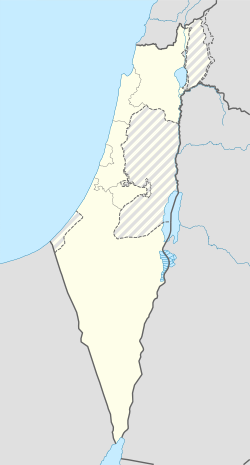world.wikisort.org - Israel
Ma'ayan Baruch (Hebrew: מַעְיַן בָּרוּךְ, lit. Blessed Spring) is a kibbutz in northern Israel. Located near the intersection of the Israeli, Syrian and Lebanese border, it falls under the jurisdiction of Upper Galilee Regional Council. In 2014 it had a population of 720.[1]
Ma'ayan Baruch | |
|---|---|
 Ma'ayan Baruch  Ma'ayan Baruch | |
| Coordinates: 33°14′28″N 35°36′32″E | |
| Country | |
| District | Northern |
| Council | Upper Galilee |
| Affiliation | Kibbutz Movement |
| Founded | 11 March 1947 |
| Population (2019) | 767[1] |

History
The kibbutz was founded in March 1947 on the land of Hamara, a moshav abandoned in 1920. The founders were members of other kvutzot who had met in Kfar Giladi; members of the HaTenua HaMeuhedet youth movement, members of Habonim who immigrated to British Mandate of Palestine as Ma'apilim (illegal immigrants of Aliyah Bet), and members of a garin of pioneering soldiers from South Africa who fought in the British Army during World War II.[citation needed]
After the 1948 Palestine war, Ma'ayan Baruch took over part of the land belonging to the newly depopulated Palestinian village of Al-Sanbariyya.[2]
Development projects
A new neighborhood in Ma'ayan Baruch was built to attract newcomers and bring money into the kibbutz coffers in the wake of the socio-economic problems that have affected many kibbutzim since the 1980s. The newcomers are from other kibbutzim and townships in the region, as well as other parts of the country.[3]
Landmarks
A museum which holds a collection of prehistoric artifacts found in the Hula Valley, The Prehistoric Man Museum, is located on the kibbutz. The museum collection includes the skeleton of a prehistoric woman, approximately 50 years old, buried with her dog.[4][5]
 Ma’ayan Baruch 11 March 1947
Ma’ayan Baruch 11 March 1947![Day of Aliyah - Ma'ayan Baruch 1947. The 3 Palestine Policemen include Amnon Assaf, founder of the Upper Galilee Prehistoric Museum[6]](//upload.wikimedia.org/wikipedia/commons/thumb/d/d2/%D7%9E%D7%A2%D7%99%D7%9F_%D7%91%D7%A8%D7%95%D7%9A_-_%D7%91%D7%99%D7%95%D7%9D_%D7%94%D7%A2%D7%9C%D7%99%D7%94_%D7%9C%D7%9E%D7%A2%D7%99%D7%9F_%D7%91%D7%A8%D7%95%D7%9A_%D7%94%D7%A6%D7%A8%D7%99%D7%A4%D7%99%D7%9D_%D7%94%D7%A8%D7%90%D7%A9%D7%95%D7%A0%D7%99%D7%9D_%D7%9B%D7%91%D7%A8_%D7%A2%D7%95%D7%9E%D7%93%D7%99%D7%9D_%D7%A2%D7%9C_%D7%AA%D7%99%D7%9C%D7%9D%2C_%D7%94%D7%A2%D7%91%D7%95%D7%93%D7%94_%D7%A0%D7%9E%D7%A9%D7%9B%D7%AA_%D7%A9%D7%95%D7%98%D7%A8%D7%99%D7%9D_%D7%90%D7%A0%D7%92%D7%9C%D7%99%D7%9D_%D7%A9%D7%95-JNF028674.jpeg/120px-thumbnail.jpeg) Day of Aliyah - Ma'ayan Baruch 1947. The 3 Palestine Policemen include Amnon Assaf, founder of the Upper Galilee Prehistoric Museum[6]
Day of Aliyah - Ma'ayan Baruch 1947. The 3 Palestine Policemen include Amnon Assaf, founder of the Upper Galilee Prehistoric Museum[6]- Ma'ayan Baruch. First buildings 1947
 Ma’ayan Baruch 1947
Ma’ayan Baruch 1947
Notable people
- Menashe Kadishman (born 1932), sculptor and painter
- Rela Mazali (born 1948), Israeli peace activist and writer
- Amnon Shamosh, Israeli author and poet
See also
- Notes from the Frontier, an account of life on the kibbutz in the mid-1960s by American author Hugh Nissenson.
References
- "Population in the Localities 2019" (XLS). Israel Central Bureau of Statistics. Retrieved 16 August 2020.
- Khalidi, Walid (1992). All That Remains:The Palestinian Villages Occupied and Depopulated by Israel in 1948. Washington D.C.: Institute for Palestine Studies. p. 494. ISBN 0-88728-224-5.
- Depression in Margaliot, Hope in Maayan Baruch Haaretz, 11 July 2008
- James Serpell, The domestic dog: its evolution, behaviour, and interactions with people, pp 10-12. Cambridge University Press, 1995.
- SJM Davis and FR Valla, Evidence for domestication of the dog 12,000 years ago in the Natufian of Israel, Nature 276, 608-610 (7 December 1978)
- "Founder Biography | english". www.ugmp.co.il. Archived from the original on 2014-04-14.
Другой контент может иметь иную лицензию. Перед использованием материалов сайта WikiSort.org внимательно изучите правила лицензирования конкретных элементов наполнения сайта.
WikiSort.org - проект по пересортировке и дополнению контента Википедии

![Day of Aliyah - Ma'ayan Baruch 1947. The 3 Palestine Policemen include Amnon Assaf, founder of the Upper Galilee Prehistoric Museum[6]](http://upload.wikimedia.org/wikipedia/commons/thumb/d/d2/%D7%9E%D7%A2%D7%99%D7%9F_%D7%91%D7%A8%D7%95%D7%9A_-_%D7%91%D7%99%D7%95%D7%9D_%D7%94%D7%A2%D7%9C%D7%99%D7%94_%D7%9C%D7%9E%D7%A2%D7%99%D7%9F_%D7%91%D7%A8%D7%95%D7%9A_%D7%94%D7%A6%D7%A8%D7%99%D7%A4%D7%99%D7%9D_%D7%94%D7%A8%D7%90%D7%A9%D7%95%D7%A0%D7%99%D7%9D_%D7%9B%D7%91%D7%A8_%D7%A2%D7%95%D7%9E%D7%93%D7%99%D7%9D_%D7%A2%D7%9C_%D7%AA%D7%99%D7%9C%D7%9D%2C_%D7%94%D7%A2%D7%91%D7%95%D7%93%D7%94_%D7%A0%D7%9E%D7%A9%D7%9B%D7%AA_%D7%A9%D7%95%D7%98%D7%A8%D7%99%D7%9D_%D7%90%D7%A0%D7%92%D7%9C%D7%99%D7%9D_%D7%A9%D7%95-JNF028674.jpeg/120px-thumbnail.jpeg)

